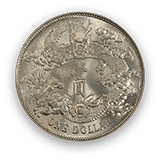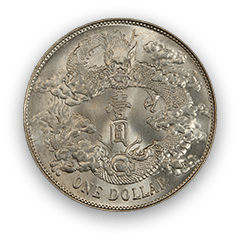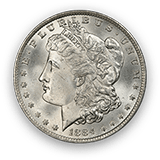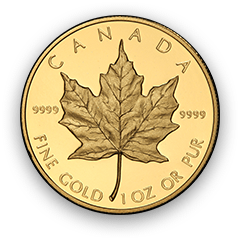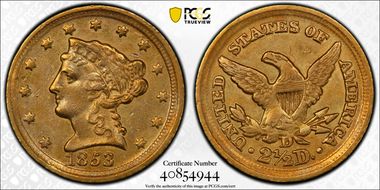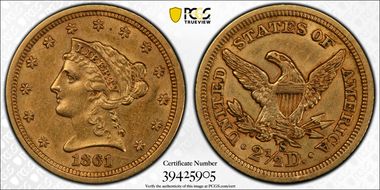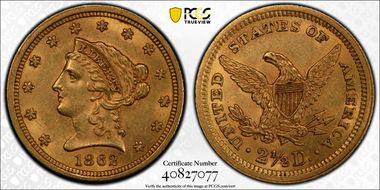hykyrone 的钱币相册
Rare (50-60 known per PCGS). As Garrett and Guth state in their "Encyclopedia Of U.S. Gold Coins 1795-1933", "As the tiny mintage suggests, the 1842 Liberty Head quarter eagle is a major rarity in any grade...A review of other auction records reveals that this date is seldom offered for sale in any grade... The 1842 quarter eagle is still very rare, much more so than many of the more popular Southern mint issues." David Akers' "An Analysis Of Auction Records - Volume II - Quarter Eagles" his average grade at the time (1975) was VF29.
Rare (50-60 known per PCGS). As Garrett and Guth state in their "Encyclopedia Of U.S. Gold Coins 1795-1933", "As the tiny mintage suggests, the 1842 Liberty Head quarter eagle is a major rarity in any grade...A review of other auction records reveals that this date is seldom offered for sale in any grade... The 1842 quarter eagle is still very rare, much more so than many of the more popular Southern mint issues." David Akers' "An Analysis Of Auction Records - Volume II - Quarter Eagles" his average grade at the time (1975) was VF29.
A single variety exists - Winter 17-N Douglas Winter's "Gold Coins of the Dahlonega Mint 1838-1861" also indicates the rarity is 7th of 20. He states, "The 1853-D quarter eagle is scarce in all grades. It is seen most often in VF to XF range..." Garrett and Guth's "Encyclopedia of U.S. Gold Coins 1795-1933" echos the rarity, stating, "As the tiny mintage suggests, the 1853-D quarter eagle must be considered rare in any grade. Perhaps fewer than 100 coins still survive in all grades."
A single variety exists - Winter 17-N Douglas Winter's "Gold Coins of the Dahlonega Mint 1838-1861" also indicates the rarity is 7th of 20. He states, "The 1853-D quarter eagle is scarce in all grades. It is seen most often in VF to XF range..." Garrett and Guth's "Encyclopedia of U.S. Gold Coins 1795-1933" echos the rarity, stating, "As the tiny mintage suggests, the 1853-D quarter eagle must be considered rare in any grade. Perhaps fewer than 100 coins still survive in all grades."
A single variety exists - Winter 17-N Douglas Winter's "Gold Coins of the Dahlonega Mint 1838-1861" also indicates the rarity is 7th of 20. He states, "The 1853-D quarter eagle is scarce in all grades. It is seen most often in VF to XF range..." Garrett and Guth's "Encyclopedia of U.S. Gold Coins 1795-1933" echos the rarity, stating, "As the tiny mintage suggests, the 1853-D quarter eagle must be considered rare in any grade. Perhaps fewer than 100 coins still survive in all grades."
A single variety exists - Winter 17-N Douglas Winter's "Gold Coins of the Dahlonega Mint 1838-1861" also indicates the rarity is 7th of 20. He states, "The 1853-D quarter eagle is scarce in all grades. It is seen most often in VF to XF range..." Garrett and Guth's "Encyclopedia of U.S. Gold Coins 1795-1933" echos the rarity, stating, "As the tiny mintage suggests, the 1853-D quarter eagle must be considered rare in any grade. Perhaps fewer than 100 coins still survive in all grades."
A single variety exists - Winter 17-N Douglas Winter's "Gold Coins of the Dahlonega Mint 1838-1861" also indicates the rarity is 7th of 20. He states, "The 1853-D quarter eagle is scarce in all grades. It is seen most often in VF to XF range..." Garrett and Guth's "Encyclopedia of U.S. Gold Coins 1795-1933" echos the rarity, stating, "As the tiny mintage suggests, the 1853-D quarter eagle must be considered rare in any grade. Perhaps fewer than 100 coins still survive in all grades."
Variety 1 (Former variety 15-I, only variety known) Garrett and Guth, in their "Encyclopedia Of U.S. Gold Coins 1795-1933" explain, "The 1854-C quarter eagle is a scarce and popular coin in all grades. Most survivors are well circulated, and Mint State examples are very rare. Coins of this date are frequently found harshly cleaned or damaged. A pleasing 1854-C quarter eagle is quite the prize. Most surviving specimens are softly struck in the center, especially on the eagle's left wing and about the shield. On the reverse a small die break runs from the fraction bar to the rim. The Smithsonian's example is a pleasing Uncirculated coin and is among the finest known." Douglas Winter, in his "Gold Coins Of the Charlotte Mint 1838-1861", lists the rarity at 6th of 20. He also states, "Only 7,295 examples were produced, giving this date the fifth lowest mintage figure of any quarter eagle from this mint. There are very few examples known that do not show extensively abraded surfaces... There is a strong die scratch [die crack] which runs from the fraction bar down to the rim on the reverse. All known examples have a small mint-made depression to the right of the eagle's neck." Mr. Winter's side bar also states, "Most often seen in the VF to EF range, the low mintage 1854-C quarter eagle is a scarce date in all grades. It is scarce in the lower AU grades and rare in properly graded AU55 to AU58." Walter Breen's "Complete Encyclopedia of U.S. And Colonial Coins", considers the 1854-C quarter eagle "Very rare." David Aker's Quarter Eagle Auction Analysis comments "The 1854-C is a very rare date in all grades and is particularly difficult to obtain in full mint state." His average grade at the time (1975) was VF35. The coin shown here has well detail stars with complete radial lines and better than average detail on the hair above the eye and above the ear. It also shows the very weak die crack at the fraction bar and no strike doubling alluded to by Mr. Winter, which may suggest an early strike in this case. Die stria are also evident at the date and some other protected areas on the obverse.
Variety 1 (Former variety 15-I, only variety known) Garrett and Guth, in their "Encyclopedia Of U.S. Gold Coins 1795-1933" explain, "The 1854-C quarter eagle is a scarce and popular coin in all grades. Most survivors are well circulated, and Mint State examples are very rare. Coins of this date are frequently found harshly cleaned or damaged. A pleasing 1854-C quarter eagle is quite the prize. Most surviving specimens are softly struck in the center, especially on the eagle's left wing and about the shield. On the reverse a small die break runs from the fraction bar to the rim. The Smithsonian's example is a pleasing Uncirculated coin and is among the finest known." Douglas Winter, in his "Gold Coins Of the Charlotte Mint 1838-1861", lists the rarity at 6th of 20. He also states, "Only 7,295 examples were produced, giving this date the fifth lowest mintage figure of any quarter eagle from this mint. There are very few examples known that do not show extensively abraded surfaces... There is a strong die scratch [die crack] which runs from the fraction bar down to the rim on the reverse. All known examples have a small mint-made depression to the right of the eagle's neck." Mr. Winter's side bar also states, "Most often seen in the VF to EF range, the low mintage 1854-C quarter eagle is a scarce date in all grades. It is scarce in the lower AU grades and rare in properly graded AU55 to AU58." Walter Breen's "Complete Encyclopedia of U.S. And Colonial Coins", considers the 1854-C quarter eagle "Very rare." David Aker's Quarter Eagle Auction Analysis comments "The 1854-C is a very rare date in all grades and is particularly difficult to obtain in full mint state." His average grade at the time (1975) was VF35. The coin shown here has well detail stars with complete radial lines and better than average detail on the hair above the eye and above the ear. It also shows the very weak die crack at the fraction bar and no strike doubling alluded to by Mr. Winter, which may suggest an early strike in this case. Die stria are also evident at the date and some other protected areas on the obverse.
Variety 1 (Former variety 15-I, only variety known) Garrett and Guth, in their "Encyclopedia Of U.S. Gold Coins 1795-1933" explain, "The 1854-C quarter eagle is a scarce and popular coin in all grades. Most survivors are well circulated, and Mint State examples are very rare. Coins of this date are frequently found harshly cleaned or damaged. A pleasing 1854-C quarter eagle is quite the prize. Most surviving specimens are softly struck in the center, especially on the eagle's left wing and about the shield. On the reverse a small die break runs from the fraction bar to the rim. The Smithsonian's example is a pleasing Uncirculated coin and is among the finest known." Douglas Winter, in his "Gold Coins Of the Charlotte Mint 1838-1861", lists the rarity at 6th of 20. He also states, "Only 7,295 examples were produced, giving this date the fifth lowest mintage figure of any quarter eagle from this mint. There are very few examples known that do not show extensively abraded surfaces... There is a strong die scratch [die crack] which runs from the fraction bar down to the rim on the reverse. All known examples have a small mint-made depression to the right of the eagle's neck." Mr. Winter's side bar also states, "Most often seen in the VF to EF range, the low mintage 1854-C quarter eagle is a scarce date in all grades. It is scarce in the lower AU grades and rare in properly graded AU55 to AU58." Walter Breen's "Complete Encyclopedia of U.S. And Colonial Coins", considers the 1854-C quarter eagle "Very rare." David Aker's Quarter Eagle Auction Analysis comments "The 1854-C is a very rare date in all grades and is particularly difficult to obtain in full mint state." His average grade at the time (1975) was VF35. The coin shown here has well detail stars with complete radial lines and better than average detail on the hair above the eye and above the ear. It also shows the very weak die crack at the fraction bar and no strike doubling alluded to by Mr. Winter, which may suggest an early strike in this case. Die stria are also evident at the date and some other protected areas on the obverse.
Variety 1 (Former variety 15-I, only variety known) Garrett and Guth, in their "Encyclopedia Of U.S. Gold Coins 1795-1933" explain, "The 1854-C quarter eagle is a scarce and popular coin in all grades. Most survivors are well circulated, and Mint State examples are very rare. Coins of this date are frequently found harshly cleaned or damaged. A pleasing 1854-C quarter eagle is quite the prize. Most surviving specimens are softly struck in the center, especially on the eagle's left wing and about the shield. On the reverse a small die break runs from the fraction bar to the rim. The Smithsonian's example is a pleasing Uncirculated coin and is among the finest known." Douglas Winter, in his "Gold Coins Of the Charlotte Mint 1838-1861", lists the rarity at 6th of 20. He also states, "Only 7,295 examples were produced, giving this date the fifth lowest mintage figure of any quarter eagle from this mint. There are very few examples known that do not show extensively abraded surfaces... There is a strong die scratch [die crack] which runs from the fraction bar down to the rim on the reverse. All known examples have a small mint-made depression to the right of the eagle's neck." Mr. Winter's side bar also states, "Most often seen in the VF to EF range, the low mintage 1854-C quarter eagle is a scarce date in all grades. It is scarce in the lower AU grades and rare in properly graded AU55 to AU58." Walter Breen's "Complete Encyclopedia of U.S. And Colonial Coins", considers the 1854-C quarter eagle "Very rare." David Aker's Quarter Eagle Auction Analysis comments "The 1854-C is a very rare date in all grades and is particularly difficult to obtain in full mint state." His average grade at the time (1975) was VF35. The coin shown here has well detail stars with complete radial lines and better than average detail on the hair above the eye and above the ear. It also shows the very weak die crack at the fraction bar and no strike doubling alluded to by Mr. Winter, which may suggest an early strike in this case. Die stria are also evident at the date and some other protected areas on the obverse.
Variety 1 (Former variety 15-I, only variety known) Garrett and Guth, in their "Encyclopedia Of U.S. Gold Coins 1795-1933" explain, "The 1854-C quarter eagle is a scarce and popular coin in all grades. Most survivors are well circulated, and Mint State examples are very rare. Coins of this date are frequently found harshly cleaned or damaged. A pleasing 1854-C quarter eagle is quite the prize. Most surviving specimens are softly struck in the center, especially on the eagle's left wing and about the shield. On the reverse a small die break runs from the fraction bar to the rim. The Smithsonian's example is a pleasing Uncirculated coin and is among the finest known." Douglas Winter, in his "Gold Coins Of the Charlotte Mint 1838-1861", lists the rarity at 6th of 20. He also states, "Only 7,295 examples were produced, giving this date the fifth lowest mintage figure of any quarter eagle from this mint. There are very few examples known that do not show extensively abraded surfaces... There is a strong die scratch [die crack] which runs from the fraction bar down to the rim on the reverse. All known examples have a small mint-made depression to the right of the eagle's neck." Mr. Winter's side bar also states, "Most often seen in the VF to EF range, the low mintage 1854-C quarter eagle is a scarce date in all grades. It is scarce in the lower AU grades and rare in properly graded AU55 to AU58." Walter Breen's "Complete Encyclopedia of U.S. And Colonial Coins", considers the 1854-C quarter eagle "Very rare." David Aker's Quarter Eagle Auction Analysis comments "The 1854-C is a very rare date in all grades and is particularly difficult to obtain in full mint state." His average grade at the time (1975) was VF35. The coin shown here has well detail stars with complete radial lines and better than average detail on the hair above the eye and above the ear. It also shows the very weak die crack at the fraction bar and no strike doubling alluded to by Mr. Winter, which may suggest an early strike in this case. Die stria are also evident at the date and some other protected areas on the obverse.
Garrett and Guth state in their "Encyclopedia of U.S. Gold Coins 1795-1933", "The 1861-S quarter eagle is another issue with a moderately low mintage that was heavily circulated and has few survivors. This date is usually seen heavily worn and becomes increasingly rare in higher grades... The 1861-S quarter eagle does not garner much attention, but can be extremely difficult to locate in any grade." "Walter Breen's Complete Encyclopedia of U.S. And Colonial Coins" asserts, "'Type 1' rev. Very scarce. One obv. shipped Nov. 1860, one June 1861: leftover revs. from 1856. Much rarer in all grades than mintage figure suggests; usually weak VF, Ex. rare in EF, unknown UNC." Since his book was published in 1988, as many as 11 uncirculated coins may exist although PCGS suggests only 4 in MS60 and above. I have found 3 distinct reverse dies were used, identified by the location of the mint mark. The first has the mint mark slanted right with the lower serif of the S almost touching the fraction bar (see PCGS website MS62+ photo). The second is more upright and positioned above the upper serif of the D (see PCGS website AU58 photos). The third has the mint mark positioned left between the 1 in the fraction and the fraction bar (see NGC website sn 3516516-010 AU55)(This appears to be the rarest of the three and its the best photo I could find - sorry). This coin has the upright mint mark above the D upper serif. There is also a contact mark (point) between stars 7 and 8. Pedigree: Maurice Storck Collection (2020)
Garrett and Guth state in their "Encyclopedia of U.S. Gold Coins 1795-1933", "The 1861-S quarter eagle is another issue with a moderately low mintage that was heavily circulated and has few survivors. This date is usually seen heavily worn and becomes increasingly rare in higher grades... The 1861-S quarter eagle does not garner much attention, but can be extremely difficult to locate in any grade." "Walter Breen's Complete Encyclopedia of U.S. And Colonial Coins" asserts, "'Type 1' rev. Very scarce. One obv. shipped Nov. 1860, one June 1861: leftover revs. from 1856. Much rarer in all grades than mintage figure suggests; usually weak VF, Ex. rare in EF, unknown UNC." Since his book was published in 1988, as many as 11 uncirculated coins may exist although PCGS suggests only 4 in MS60 and above. I have found 3 distinct reverse dies were used, identified by the location of the mint mark. The first has the mint mark slanted right with the lower serif of the S almost touching the fraction bar (see PCGS website MS62+ photo). The second is more upright and positioned above the upper serif of the D (see PCGS website AU58 photos). The third has the mint mark positioned left between the 1 in the fraction and the fraction bar (see NGC website sn 3516516-010 AU55)(This appears to be the rarest of the three and its the best photo I could find - sorry). This coin has the upright mint mark above the D upper serif. There is also a contact mark (point) between stars 7 and 8. Pedigree: Maurice Storck Collection (2020)
Garrett and Guth state in their "Encyclopedia of U.S. Gold Coins 1795-1933", "The 1861-S quarter eagle is another issue with a moderately low mintage that was heavily circulated and has few survivors. This date is usually seen heavily worn and becomes increasingly rare in higher grades... The 1861-S quarter eagle does not garner much attention, but can be extremely difficult to locate in any grade." "Walter Breen's Complete Encyclopedia of U.S. And Colonial Coins" asserts, "'Type 1' rev. Very scarce. One obv. shipped Nov. 1860, one June 1861: leftover revs. from 1856. Much rarer in all grades than mintage figure suggests; usually weak VF, Ex. rare in EF, unknown UNC." Since his book was published in 1988, as many as 11 uncirculated coins may exist although PCGS suggests only 4 in MS60 and above. I have found 3 distinct reverse dies were used, identified by the location of the mint mark. The first has the mint mark slanted right with the lower serif of the S almost touching the fraction bar (see PCGS website MS62+ photo). The second is more upright and positioned above the upper serif of the D (see PCGS website AU58 photos). The third has the mint mark positioned left between the 1 in the fraction and the fraction bar (see NGC website sn 3516516-010 AU55)(This appears to be the rarest of the three and its the best photo I could find - sorry). This coin has the upright mint mark above the D upper serif. There is also a contact mark (point) between stars 7 and 8. Pedigree: Maurice Storck Collection (2020)
Garrett and Guth in their "Encyclopedia of U.S. Gold Coins 1795-1933" state, "The mintage of the 1862 quarter eagle dropped considerably at the Philadelphia Mint from the previous year. Even with a rather substantial production of nearly 100,000 coins, this date is scarce in all grades. The 1862 quarter eagle is many, many times rarer than the 1861. Gold coinage after the start of the Civil War did not circulate with regularity, and many great rarities were produced during this era. Most of the examples seen of this date are well struck, some with die clashes visible on one or both sides." Subtle die clashing on this coin can be seen with the aid of a loupe.
Garrett and Guth in their "Encyclopedia of U.S. Gold Coins 1795-1933" state, "The mintage of the 1862 quarter eagle dropped considerably at the Philadelphia Mint from the previous year. Even with a rather substantial production of nearly 100,000 coins, this date is scarce in all grades. The 1862 quarter eagle is many, many times rarer than the 1861. Gold coinage after the start of the Civil War did not circulate with regularity, and many great rarities were produced during this era. Most of the examples seen of this date are well struck, some with die clashes visible on one or both sides." Subtle die clashing on this coin can be seen with the aid of a loupe.
Garrett and Guth in their "Encyclopedia of U.S. Gold Coins 1795-1933" state, "The mintage of the 1862 quarter eagle dropped considerably at the Philadelphia Mint from the previous year. Even with a rather substantial production of nearly 100,000 coins, this date is scarce in all grades. The 1862 quarter eagle is many, many times rarer than the 1861. Gold coinage after the start of the Civil War did not circulate with regularity, and many great rarities were produced during this era. Most of the examples seen of this date are well struck, some with die clashes visible on one or both sides." Subtle die clashing on this coin can be seen with the aid of a loupe.
PCGS estimated survival of 80. Walter Breen's monograph "New Varieties of $1, $2.50 and $5 US Gold" pg 8, comments "One of the most undervalued of all S mint quarter eagles; fewer are around than the 1875 S or 76 S." This is still true today for these two dates with the 75-S at 326 graded and the 76-S at 272 graded. Breen's "Complete Encyclopedia" lists the 1862-S as "Very Rare", "Usually VF; Ex rare above", "S-Mint coins continue to have "Type 1" rev. through 1876". David Akers' "United States Gold Coins - An Auction Analysis of Auction Records - Volume II - Quarter Eagles 1796-1929" echoes the sentiment, "Very rare in all grades and extremely underrated. This date is seldom available in any condition and its 24 appearances in 226 auctions places it in tenth in the entire quarter eagle series according to rarity by number of appearances... Without a doubt, the 1862-S is one of the major "sleepers" in the entire quarter eagle series and any specimen grading EF or better should be considered highly desirable." His average grade at the time (1975) shows an average grade of VF34. Garrett and Guth's "Encyclopedia Of U.S. Gold Coins 1795-1933" comments, "The 1862-S quarter eagle was struck in far fewer numbers than coins of previous years at the San Francisco Mint. This date is very rare an any grade and extremely rare in Mint State. Most of the 1862-S quarter eagles are well worn or damaged... The Smithsonian example is About Uncirculated and is among the finest survivors for the date." The Smithsonian coin is graded AU50
PCGS estimated survival of 80. Walter Breen's monograph "New Varieties of $1, $2.50 and $5 US Gold" pg 8, comments "One of the most undervalued of all S mint quarter eagles; fewer are around than the 1875 S or 76 S." This is still true today for these two dates with the 75-S at 326 graded and the 76-S at 272 graded. Breen's "Complete Encyclopedia" lists the 1862-S as "Very Rare", "Usually VF; Ex rare above", "S-Mint coins continue to have "Type 1" rev. through 1876". David Akers' "United States Gold Coins - An Auction Analysis of Auction Records - Volume II - Quarter Eagles 1796-1929" echoes the sentiment, "Very rare in all grades and extremely underrated. This date is seldom available in any condition and its 24 appearances in 226 auctions places it in tenth in the entire quarter eagle series according to rarity by number of appearances... Without a doubt, the 1862-S is one of the major "sleepers" in the entire quarter eagle series and any specimen grading EF or better should be considered highly desirable." His average grade at the time (1975) shows an average grade of VF34. Garrett and Guth's "Encyclopedia Of U.S. Gold Coins 1795-1933" comments, "The 1862-S quarter eagle was struck in far fewer numbers than coins of previous years at the San Francisco Mint. This date is very rare an any grade and extremely rare in Mint State. Most of the 1862-S quarter eagles are well worn or damaged... The Smithsonian example is About Uncirculated and is among the finest survivors for the date." The Smithsonian coin is graded AU50
PCGS estimated survival of 80. Walter Breen's monograph "New Varieties of $1, $2.50 and $5 US Gold" pg 8, comments "One of the most undervalued of all S mint quarter eagles; fewer are around than the 1875 S or 76 S." This is still true today for these two dates with the 75-S at 326 graded and the 76-S at 272 graded. Breen's "Complete Encyclopedia" lists the 1862-S as "Very Rare", "Usually VF; Ex rare above", "S-Mint coins continue to have "Type 1" rev. through 1876". David Akers' "United States Gold Coins - An Auction Analysis of Auction Records - Volume II - Quarter Eagles 1796-1929" echoes the sentiment, "Very rare in all grades and extremely underrated. This date is seldom available in any condition and its 24 appearances in 226 auctions places it in tenth in the entire quarter eagle series according to rarity by number of appearances... Without a doubt, the 1862-S is one of the major "sleepers" in the entire quarter eagle series and any specimen grading EF or better should be considered highly desirable." His average grade at the time (1975) shows an average grade of VF34. Garrett and Guth's "Encyclopedia Of U.S. Gold Coins 1795-1933" comments, "The 1862-S quarter eagle was struck in far fewer numbers than coins of previous years at the San Francisco Mint. This date is very rare an any grade and extremely rare in Mint State. Most of the 1862-S quarter eagles are well worn or damaged... The Smithsonian example is About Uncirculated and is among the finest survivors for the date." The Smithsonian coin is graded AU50
PCGS estimated survival of 80. Walter Breen's monograph "New Varieties of $1, $2.50 and $5 US Gold" pg 8, comments "One of the most undervalued of all S mint quarter eagles; fewer are around than the 1875 S or 76 S." This is still true today for these two dates with the 75-S at 326 graded and the 76-S at 272 graded. Breen's "Complete Encyclopedia" lists the 1862-S as "Very Rare", "Usually VF; Ex rare above", "S-Mint coins continue to have "Type 1" rev. through 1876". David Akers' "United States Gold Coins - An Auction Analysis of Auction Records - Volume II - Quarter Eagles 1796-1929" echoes the sentiment, "Very rare in all grades and extremely underrated. This date is seldom available in any condition and its 24 appearances in 226 auctions places it in tenth in the entire quarter eagle series according to rarity by number of appearances... Without a doubt, the 1862-S is one of the major "sleepers" in the entire quarter eagle series and any specimen grading EF or better should be considered highly desirable." His average grade at the time (1975) shows an average grade of VF34. Garrett and Guth's "Encyclopedia Of U.S. Gold Coins 1795-1933" comments, "The 1862-S quarter eagle was struck in far fewer numbers than coins of previous years at the San Francisco Mint. This date is very rare an any grade and extremely rare in Mint State. Most of the 1862-S quarter eagles are well worn or damaged... The Smithsonian example is About Uncirculated and is among the finest survivors for the date." The Smithsonian coin is graded AU50
Garrett and Guth's "Encyclopedia of U.S. Gold Coins" comments, "Quarter eagles from the San Francisco Mint of this era all share common themes - they are usually found well worn and are rare in high grade. The 1869-S is no exception, as most of the coins are found for this year are relatively low grade." David Akers, in his Auction Analysis of 1975 suggested, "Scarce as a date... Most specimens I have seen were very bluntly struck and have relatively little detail on the hair around Liberty's face or on the eagle's right leg and neck... grossly underpriced, particularly in choice condition." He gave the 1869-S quarter eagle an average grade of VF30 although the current graded population suggest a better average would be in the VF45-AU50 range.
Garrett and Guth's "Encyclopedia of U.S. Gold Coins" comments, "Quarter eagles from the San Francisco Mint of this era all share common themes - they are usually found well worn and are rare in high grade. The 1869-S is no exception, as most of the coins are found for this year are relatively low grade." David Akers, in his Auction Analysis of 1975 suggested, "Scarce as a date... Most specimens I have seen were very bluntly struck and have relatively little detail on the hair around Liberty's face or on the eagle's right leg and neck... grossly underpriced, particularly in choice condition." He gave the 1869-S quarter eagle an average grade of VF30 although the current graded population suggest a better average would be in the VF45-AU50 range.
As Garrett and Guth suggest in their "Encyclopedia Of U.S. Gold Coins 1795-1933", "This date is another in a series of very low-production issues... The 1883 quarter eagle is a very rare coin in all grades... As usual for the low-mintage issues, most 1883 quarter eagles are seen with deeply reflective, prooflike surfaces." An interesting note regarding the 1883 is the die clash marks below the R in LIBERTY which end as a rectangular mark inside Liberty's ear (vertical shield lines [pale gules]). From what I have been able to discern, Proof coins do not have this die clash while business strikes do. This may be a diagnostic for proof versus business strikes, although it is an area of research that I have not yet been able to devote time to. Also the Y in LIBERTY appears to have been repunched low. The survival estimate listed on the PCGS website seems to be out of line with other coins in the series. With a graded population of 166 by PCGS and NGC (including resubmissions) the estimate of 250 total surviving appears inflated. Maybe a typo? 150 (R7.5) would seem to be a more realistic number especially with a total mintage of only 1920 business strikes.
As Garrett and Guth suggest in their "Encyclopedia Of U.S. Gold Coins 1795-1933", "This date is another in a series of very low-production issues... The 1883 quarter eagle is a very rare coin in all grades... As usual for the low-mintage issues, most 1883 quarter eagles are seen with deeply reflective, prooflike surfaces." An interesting note regarding the 1883 is the die clash marks below the R in LIBERTY which end as a rectangular mark inside Liberty's ear (vertical shield lines [pale gules]). From what I have been able to discern, Proof coins do not have this die clash while business strikes do. This may be a diagnostic for proof versus business strikes, although it is an area of research that I have not yet been able to devote time to. Also the Y in LIBERTY appears to have been repunched low. The survival estimate listed on the PCGS website seems to be out of line with other coins in the series. With a graded population of 166 by PCGS and NGC (including resubmissions) the estimate of 250 total surviving appears inflated. Maybe a typo? 150 (R7.5) would seem to be a more realistic number especially with a total mintage of only 1920 business strikes.
As Garrett and Guth suggest in their "Encyclopedia Of U.S. Gold Coins 1795-1933", "This date is another in a series of very low-production issues... The 1883 quarter eagle is a very rare coin in all grades... As usual for the low-mintage issues, most 1883 quarter eagles are seen with deeply reflective, prooflike surfaces." An interesting note regarding the 1883 is the die clash marks below the R in LIBERTY which end as a rectangular mark inside Liberty's ear (vertical shield lines [pale gules]). From what I have been able to discern, Proof coins do not have this die clash while business strikes do. This may be a diagnostic for proof versus business strikes, although it is an area of research that I have not yet been able to devote time to. Also the Y in LIBERTY appears to have been repunched low. The survival estimate listed on the PCGS website seems to be out of line with other coins in the series. With a graded population of 166 by PCGS and NGC (including resubmissions) the estimate of 250 total surviving appears inflated. Maybe a typo? 150 (R7.5) would seem to be a more realistic number especially with a total mintage of only 1920 business strikes.
